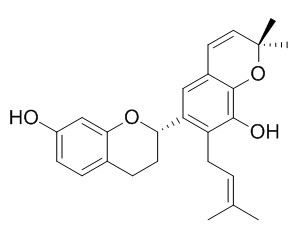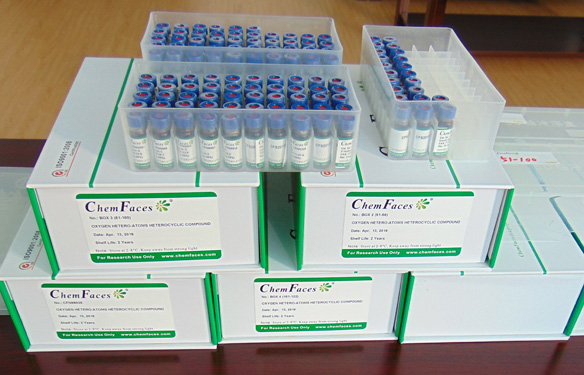Kazinol B
Kazinol B inhibits the NO synthesis with an IC(50) of 21.6 microM.
It can stimulate respiratory burst, is probably mediated by the synergism of PKC activation and [Ca2+]i elevation in rat neutrophils. Kazinol B stimulates Ca(2+) release from internal Ca(2+) store, probably through the sphingosine 1-phosphate and IP(3) signaling, and activates external Ca(2+) influx mainly through a non-store-operated Ca(2+) entry (non-SOCE) pathway. Kazinol B improves insulin sensitivity via Akt and AMPK activation in 3T3-L1 adipocytes, it might be a therapeutic candidate for diabetes mellitus.
Inquire / Order:
manager@chemfaces.com
Technical Inquiries:
service@chemfaces.com
Tel:
+86-27-84237783
Fax:
+86-27-84254680
Address:
1 Building, No. 83, CheCheng Rd., Wuhan Economic and Technological Development Zone, Wuhan, Hubei 430056, PRC
Providing storage is as stated on the product vial and the vial is kept tightly sealed, the product can be stored for up to
24 months(2-8C).
Wherever possible, you should prepare and use solutions on the same day. However, if you need to make up stock solutions in advance, we recommend that you store the solution as aliquots in tightly sealed vials at -20C. Generally, these will be useable for up to two weeks. Before use, and prior to opening the vial we recommend that you allow your product to equilibrate to room temperature for at least 1 hour.
Need more advice on solubility, usage and handling? Please email to: service@chemfaces.com
The packaging of the product may have turned upside down during transportation, resulting in the natural compounds adhering to the neck or cap of the vial. take the vial out of its packaging and gently shake to let the compounds fall to the bottom of the vial. for liquid products, centrifuge at 200-500 RPM to gather the liquid at the bottom of the vial. try to avoid loss or contamination during handling.
Korean J. of Food Sci. and Tech2016, 172-177
J Agric Food Chem.2024, 72(15):8784-8797.
J Med Food.2019, 22(10):1067-1077
J Biomol Struct Dyn.2023, 1-21.
Plants (Basel).2024, 13(23):3314.
University of Central Lancashire2017, 20472
Journal of Research in Pharmacy.2022, 26(6):p1752-1757.
J Agric Food Chem.2024, 72(45):25219-25228.
Int J Mol Sci.2021, 22(16):8641.
Planta Med.2018, 84(15):1101-1109
Related and Featured Products
Fitoterapia. 2003 Jun;74(4):350-4.
Inhibition of nitric oxide production on LPS-activated macrophages by kazinol B from Broussonetia kazinoki.[Pubmed:
12781805]
METHODS AND RESULTS:
The ethyl acetate soluble fraction of Broussonetia kazinoki at 50 microg/ml showed a significant inhibition (78.2%) of nitric oxide (NO) in lipopolysaccharide activated macrophages. Kazinol B, an isoprenylated flavan, was identified as the active principle. It inhibits the NO synthesis with an IC(50) of 21.6 microM.
Naunyn Schmiedebergs Arch Pharmacol. 2004 Dec;370(6):500-9.
Stimulation of cellular free Ca2+ elevation and inhibition of store-operated Ca2+ entry by kazinol B in neutrophils.[Pubmed:
15558242]
Kazinol B, a natural isoprenylated flavan, stimulated the [Ca(2+)](i) elevation in the presence or absence of Ca(2+) in the medium.
METHODS AND RESULTS:
Treatment with chymotrypsin or phorbol 12-myristate 13-acetate to shedding of L: -selectin had no effect on subsequent Kazinol B-induced Ca(2+) response. Upon initial cyclopiazonic acid (CPA) treatment in the absence of external Ca(2+), the subsequent [Ca(2+)](i) rise followed by challenge with Kazinol B was greatly diminished. The ryanodine receptor blockers, 8-bromo-cyclic ADP-ribose and ruthenium red did not affect Kazinol B-evoked Ca(2+) release from internal stores. However, the inhibitors of sphingosine kinase, dimethylsphingosine, but not dihydrosphingosine, inhibited Kazinol B-induced Ca(2+) release. Kazinol B-induced [Ca(2+)](i) rise was not affected by two nitric oxidase inhibitors, N-(3-aminomethyl)benzylacetamidine (1400W) and 7-nitroindazole, cytochalasin B and Na(+)-deprivation.Kazinol B did not evoke any appreciable Ba(2+) and Sr(2+) entry into cells. The Ca(2+) entry blockers, 1-[beta-[3-(4-methoxyphenyl)propoxy]-4-methoxyphenethyl]-1H-imidazole (SKF-96365), but not cis-N-(2-phenylcyclopentyl)azacyclotridec-1-en-2-amine (MDL-12,330A), inhibited a Kazinol B-induced [Ca(2+)](i) rise. Kazinol B had no effect on the pharmacologically isolated plasma membrane Ca(2+)-ATPase activity. In a Ca(2+)-free medium, Kazinol B inhibited the subsequent Ca(2+) addition, resulting in robust entry in CPA- and formyl peptide-activated cells. Kazinol B produced a concentration-dependent reduction in the mitochondrial membrane potential.
CONCLUSIONS:
These results indicate that Kazinol B stimulates Ca(2+) release from internal Ca(2+) store, probably through the sphingosine 1-phosphate and IP(3) signaling, and activates external Ca(2+) influx mainly through a non-store-operated Ca(2+) entry (non-SOCE) pathway. Inhibition of SOCE by Kazinol B is probably attributable to a break in the Ca(2+) driven force of mitochondria.
Br J Pharmacol. 1998 Oct;125(3):517-25.
The signal transduction mechanism involved in kazinol B-stimulated superoxide anion generation in rat neutrophils.[Pubmed:
9806335]
METHODS AND RESULTS:
1. In this study, the underlying mechanism of stimulation of respiratory burst by Kazinol B, a natural isoprenylated flavan, in rat neutrophils in vitro was investigated. 2. Kazinol B concentration-dependently stimulated the superoxide anion (O2*-) generation, with a lag but transient activation profile, in neutrophils but not in a cell-free system. The maximum response (13.2+/-1.4 nmol O2*- 10 min(-1) per 10(6) cells) was observed at 10 microM Kazinol B. 3. Pretreatment of neutrophils with phorbol 12-myristate 13-acetate (PMA) or formylmethionyl-leucyl-phenylalanine (fMLP) significantly enhanced the O2*- generation following the subsequent stimulation of cells with Kazinol B. 4. Cells pretreated with EGTA or a protein kinase inhibitor staurosporine effectively attenuated the Kazinol B-induced O2*- generation. However, a p38 mitogen-activated protein kinase (MAPK) inhibitor SB203580 and a phosphoinositide 3-kinase (PI3K) inhibitor wortmannin had no effect on the Kazinol B-induced response. 5. Kazinol B significantly stimulated [Ca2+]i elevation in neutrophils, with a lag and slow rate of rise activation profile, and this response was attenuated by a phospholipase C (PLC) inhibitor U73122. Kazinol B also stimulated the inositol bis- and trisphosphate (IP2 and IP3) formation with a 1 min lag time. 6. The membrane-associated PKC-alpha and PKC-theta but not PKC-iota were increased following the stimulation of neutrophils with Kazinol B. It was more rapid and sensitive in the activation of PKC-theta than PKC-alpha by Kazinol B. Kazinol B partially inhibited the [3H]phorbol 12,13-dibutyrate ([3H]PDB) binding to the neutrophil cytosolic PKC. 7. Neither the cellular mass of phosphatidic acid (PA) and phosphatidylethanol (PEt), in the presence of ethanol, nor the protein tyrosine phosphorylation were stimulated by Kazinol B. In addition, the Kazinol B-induced O2*- generation remained relatively unchanged in cells pretreated with ethanol or a tyrosine kinase inhibitor genistein.
CONCLUSIONS:
8. Collectively, these results indicate that the stimulation of the respiratory burst by Kazinol B is probably mediated by the synergism of PKC activation and [Ca2+]i elevation in rat neutrophils.
Fitoterapia. 2016 Jul;112:90-6.
Kazinol B from Broussonetia kazinoki improves insulin sensitivity via Akt and AMPK activation in 3T3-L1 adipocytes.[Pubmed:
27223849 ]
In this study, we evaluated the insulin-sensitizing effect of flavans purified from Broussonetia kazinoki Siebold (BK) on 3T3-L1 adipocytes.
METHODS AND RESULTS:
Among the tested compounds, Kazinol B enhanced intracellular lipid accumulation, gene expression of proliferator-activated receptorγ (PPARγ) and CCAAT/enhancer binding protein-alpha (C/EBPα), and consistently induced PPARγ transcriptional activation. To further investigate the insulin-sensitizing effect of Kazinol B, we measured glucose analogue uptake by fully differentiated adipocytes and myotubes. Kazinol B increased 2-[N-(7-nitrobenz-2-oxa-1,3-diazol-4-yl)amino]-2-deoxy-d-glucose (2-NBDG) uptake by cells by upregulating the gene expression and translocation of glucose transporter 4 (GLUT-4) into the plasma membrane in adipocytes. Kazinol B stimulated the gene expression and secretion of adiponectin, which is associated with a low risk of types 1 and 2 diabetes mellitus. We also suggested the mechanism of the antidiabetic effect of Kazinol B by assaying Akt and AMP-activated protein kinase (AMPK) phosphorylation.
CONCLUSIONS:
In conclusion, Kazinol B isolated from BK improved insulin sensitivity by enhancing glucose uptake via the insulin-Akt signaling pathway and AMPK activation. These results suggest that Kazinol B might be a therapeutic candidate for diabetes mellitus.



